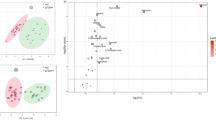Abstract
Objectives
To study the characteristics of serum metabonomics in coronary heart disease (CHD) patients diagnosed as phlegm or blood stasis pattern and explore effects of formula-pattern correspondence treatment.
Methods
A total of 102 stable CHD patients were enrolled and divided into phlegm group (P group, n=52) and blood stasis group (BS group, n=50) according to pattern identifification. Gualou Xiebai Banxia Decoction (瓜蒌薤白半夏汤, GXBD) and Xuefu Zhuyu Decoction (血府逐瘀汤, XZD) were used as drug interventions. Relevant indicators of metabonomics were observed by ultra performance liquid chromatography mass spectrometry (UPLC-MS) and pattern recognition.
Results
Levels of amino acids and phosphatidylethanolamine (PE) in the CHD group were much higher than those in healthy control group, while the levels of unsaturated fatty acids, sphingosine, Lyso, phosphatidylcholine (PC) were signifificantly lower (P<0.01). Most of the differential metabolites between the CHD and the healthy groups were also common metabolites of phlegm and blood stasis. 7(Z), 10(Z)-hexadecadienoic acid and DPA were decreased in the P group and increased in the BS group. According to the quantity of retraced metabolites, improvement in metabonomics by formula-pattern correspondence was superior to that without correspondence in the BS group. Based on the varieties of metabolites, GXBD could improve the levels of docosapentaenoic acid (DPA), sphingomyelin (SM) (d34:1), and L-Lactic acid and XZD could ameliorate the levels of sphingosine and Vit E in the P group. In the BS group, GXBD could improve vitamin E level and XZD could make improvements in the levels of octadecanoic acid, phosphoglycerol, and SM (d34:1).
Conclusions
Phlegm and blood stasis in CHD patients present specifific differential metabolites, and share common metabolites. Remarkable differences have been displayed in pathological properties and severity of phlegm and blood stasis. Patients with phlegm are more likely to have lipid metabolism disorders. However, in patients with blood stasis, problems mainly lie in glucose, protein and fat metabolism and the injury of vascular cell membrane is relatively severe. The metabolic disorder is more complicated in blood stasis pattern than that in phlegm pattern. Compared with non-correspondence, improvement of differential metabolites is more comprehensive and targeted in formulapattern correspondence with a better effect.
Similar content being viewed by others
References
Wang LX, Yang MZ, Zhang ZK, Liu XS, Zhao DX. Thoughts on studying Chinese medicine syndromes by applying metabolomics. J Guangzhou Univ Tradit Chin Med (Chin) 2008;24:366–370.
Zhou MM, Liu P, Jia W, Zhao AH, Qiu MF, Qiu YP, et al. Study on the method of evaluating the whole effect of traditional Chinese medicine based on the change of metabolic network. World Sci Tech/Modern Tradit Chin Med Mater Med (Chin) 2006;8:113–119.
Report of the Joint International Society and Federation of Cardiology/World Health Organization Task Force on Standardization of Clinical Nomenclature. Nomenclature and Criteria for Diagnosis of Ischemic Heart Disease. Chin J Cardiol (Chin) 1981;9:25.
China Society of Integrated Traditional Chinese and Western Medicine, Cardiovascular Society, Standard of TCM Pattern Identification on CHD. Chin J Integr Tradit West Med (Chin) 1991;11:257.
Chen KJ, ed. Study on promoting blood circulation to remove blood stasis and clinical. Beijing: Joint Publishing House of Beijing Medical University and China Union Medical University; 1993:3–7.
Diagnostic criteria of phlegm by Professional Committee on Phlegm of the World Federation of Traditional Chinese Medicine (TCM). Chin J Integr Tradit West Med (Chin) 2016;36:776-777.
Liao XY. Clinical guidelines for chronic stable angina(1999)—jointly agreed by American Cardiology College/American Heart Association/American College of Physicians and American Society of Internal Medicine. Lingnan J Cardiovascul Dis (Chin) 2000;6:215–216.
Deng DJ, Li DM, Jiang YX, Liu XL, Huang MY, Liu YY, et al. Changes of serum free amino acid in patients with coronary heart disease. Pract Geriatr (Chin) 1991;5:114–115.
Luo LP, Xu AP, Yin F, Han LH, Dai RJ. Clinical study on serum amino acids in patients with acute cardiovascular disease. Chin J Pract Intern Med (Chin) 1998;18:744–745.
Shi Q, Wang W, Li YL, Chen JX, Zhao HH. Blood stasis syndrome identification modes of coronary heart disease based on metabolomics. Chin J Integr Med Cardio-/cerebrovas Dis (Chin) 2014;12:513–516.
Jian WX, Yuan ZK, Huang XP, Chen QH, Zheng JH, Li YH, et al. Detection and analysis on plasma metabolomics in patients with coronary heart disease of heart-blood stasis syndrome pattern. Chin J Integr Tradit West Med (Chin) 2010;30:579–584.
Author information
Authors and Affiliations
Corresponding author
Additional information
Supported by the National Natural Science Foundation of China (No. 30901891)
Electronic supplementary material
11655_2018_2564_MOESM1_ESM.docx
Study of Serum Metabonomics and Formula-Pattern Correspondence in Coronary Heart Disease Patients Diagnosed as Phlegm or Blood Stasis Pattern Based on Ultra Performance Liquid Chromatography Mass Spectrometry
Rights and permissions
About this article
Cite this article
Lu, Xy., Xu, H., Zhao, T. et al. Study of Serum Metabonomics and Formula-Pattern Correspondence in Coronary Heart Disease Patients Diagnosed as Phlegm or Blood Stasis Pattern Based on Ultra Performance Liquid Chromatography Mass Spectrometry. Chin. J. Integr. Med. 24, 905–911 (2018). https://doi.org/10.1007/s11655-018-2564-7
Accepted:
Published:
Issue Date:
DOI: https://doi.org/10.1007/s11655-018-2564-7




